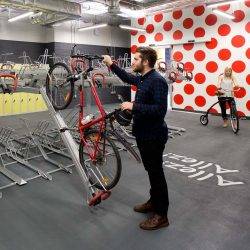July 20, 2017
People who are not economically active should be helped into the gig economy claims think tank
 Following last week’s publication of the Taylor Review into modern working practices, a new study from public sector think tank Reform makes recommendations for how government should help people into the gig economy, with a focus on those who are often economically inactive or restricted in the opportunities they have. In the report, Gainful Gigging, older and disabled people are explored as potential winners from recent growth in flexible working. Both groups are significantly less likely than average to be economically active, and many face significant work barriers. Around half of all 50-64 year olds manage at least one long-term health condition. Of the 3 million in this age group that are economically inactive, around 12 per cent spend over 20 hours per week looking after a sick, disabled or elderly person. Greater work flexibility could help them to enter the labour market, according to the report’s authors. In a survey of disability benefit claimants, many indicated that “flexible work, working from home [and] working less than 16 hours per week” would help them sustain employment. A review of the Work Capability Assessment for sickness benefits also found half of those deemed ‘fit for work’ require flexible work hours.
Following last week’s publication of the Taylor Review into modern working practices, a new study from public sector think tank Reform makes recommendations for how government should help people into the gig economy, with a focus on those who are often economically inactive or restricted in the opportunities they have. In the report, Gainful Gigging, older and disabled people are explored as potential winners from recent growth in flexible working. Both groups are significantly less likely than average to be economically active, and many face significant work barriers. Around half of all 50-64 year olds manage at least one long-term health condition. Of the 3 million in this age group that are economically inactive, around 12 per cent spend over 20 hours per week looking after a sick, disabled or elderly person. Greater work flexibility could help them to enter the labour market, according to the report’s authors. In a survey of disability benefit claimants, many indicated that “flexible work, working from home [and] working less than 16 hours per week” would help them sustain employment. A review of the Work Capability Assessment for sickness benefits also found half of those deemed ‘fit for work’ require flexible work hours.




















 Commercial property occupiers remain cautious about the future, and hard data indicates that demand has, so far, been largely unaffected by Brexit, claims a new report from the British Council for Offices (BCO) . ‘Brexit and its Potential Impact on Office Demand’, examines how Brexit might impact on demand for office space on a national and regional basis through to 2022. According to the report, almost one year on from the Brexit vote the situation is one of uncertainty, feeding through to slower growth, with ‘an almost palpable sense that choppy waters lie ahead, particularly with regard to trade and movement of labour’. However, businesses continue to make long-term investments in the national economy and even in the City, some large investment banks have committed to large new office buildings. There is much variation in the relative performance of the UK’s major office centres, though, with some expanding and others apparently in decline.
Commercial property occupiers remain cautious about the future, and hard data indicates that demand has, so far, been largely unaffected by Brexit, claims a new report from the British Council for Offices (BCO) . ‘Brexit and its Potential Impact on Office Demand’, examines how Brexit might impact on demand for office space on a national and regional basis through to 2022. According to the report, almost one year on from the Brexit vote the situation is one of uncertainty, feeding through to slower growth, with ‘an almost palpable sense that choppy waters lie ahead, particularly with regard to trade and movement of labour’. However, businesses continue to make long-term investments in the national economy and even in the City, some large investment banks have committed to large new office buildings. There is much variation in the relative performance of the UK’s major office centres, though, with some expanding and others apparently in decline.
 The quality of the cycling facilities being offered by many workplaces are currently falling short and risk undermining a Government drive to increase the number of people cycling to work; as according to new research published by the British Council for Offices, 16 percent of office workers claim that inadequate facilities are discouraging them from considering commuting by bike. In April, the Department for Transport stated an aim to double the number of cycling stages, defined as a change in the form of transport as part of a longer “trip” (e.g. cycling to the train station before catching a train to work), from 0.8 billion stages in 2013 to 1.6 billion in 2025. However, new research, commissioned by the British Council for Offices and carried out by Remit Consulting, finds that whilst 83 percent of workplaces in the UK offer some form of bike storage, less than half (47 percent) of this is covered and secure. Improved parking facilities could help increase numbers of those cycling to work, with 16 percent of office workers surveyed saying that better bike storage would encourage them to do so.
The quality of the cycling facilities being offered by many workplaces are currently falling short and risk undermining a Government drive to increase the number of people cycling to work; as according to new research published by the British Council for Offices, 16 percent of office workers claim that inadequate facilities are discouraging them from considering commuting by bike. In April, the Department for Transport stated an aim to double the number of cycling stages, defined as a change in the form of transport as part of a longer “trip” (e.g. cycling to the train station before catching a train to work), from 0.8 billion stages in 2013 to 1.6 billion in 2025. However, new research, commissioned by the British Council for Offices and carried out by Remit Consulting, finds that whilst 83 percent of workplaces in the UK offer some form of bike storage, less than half (47 percent) of this is covered and secure. Improved parking facilities could help increase numbers of those cycling to work, with 16 percent of office workers surveyed saying that better bike storage would encourage them to do so.










